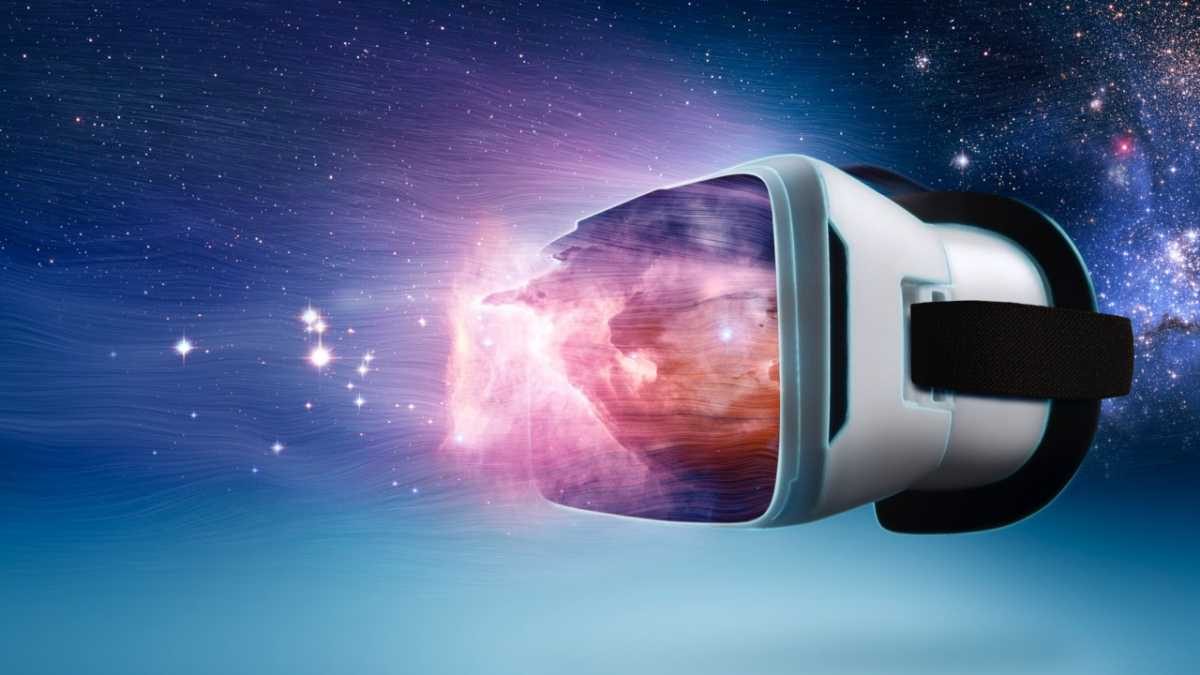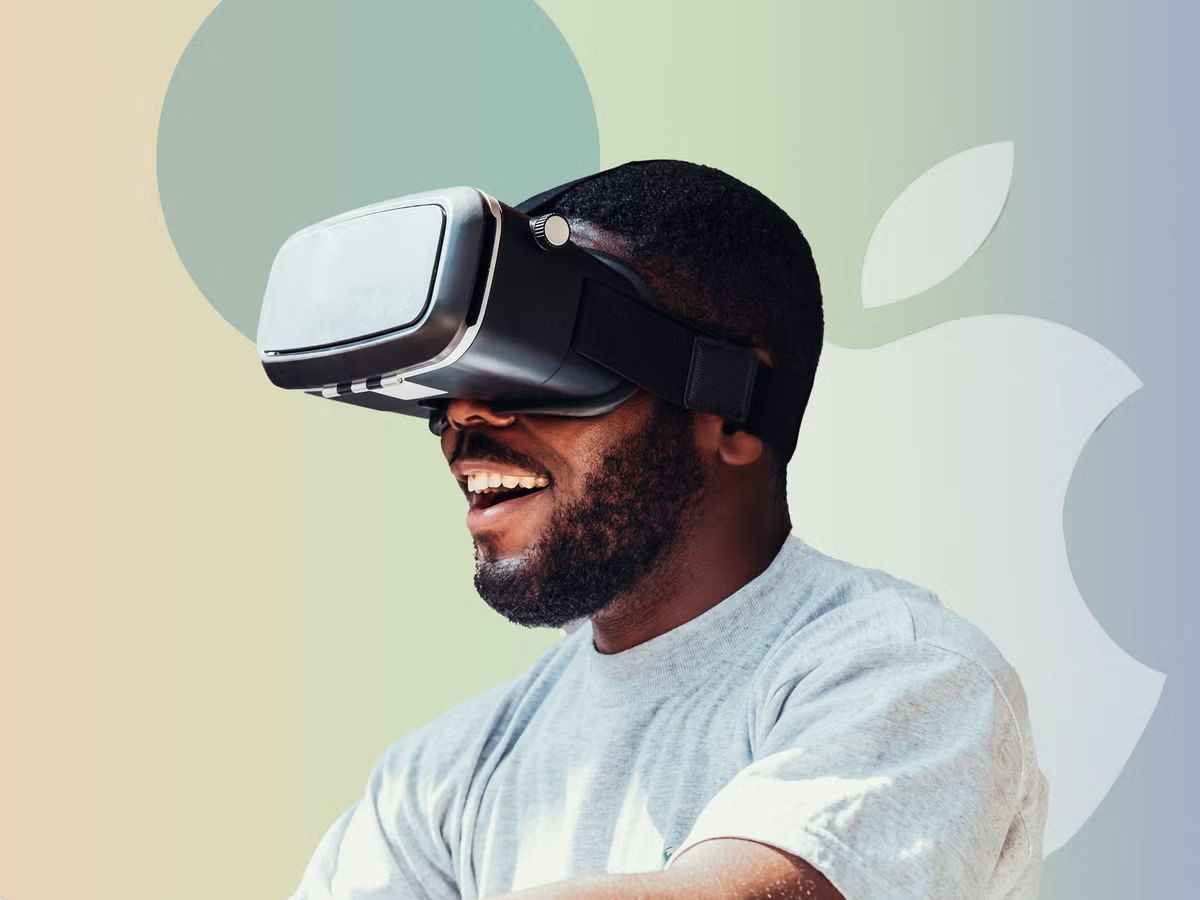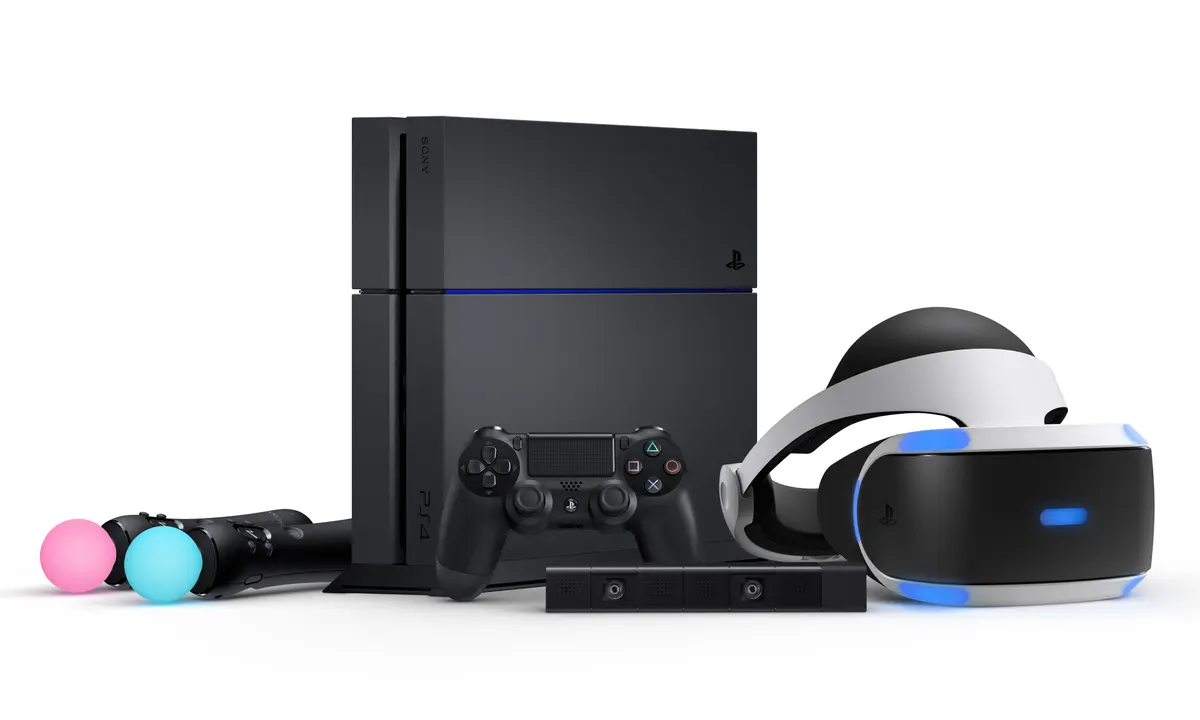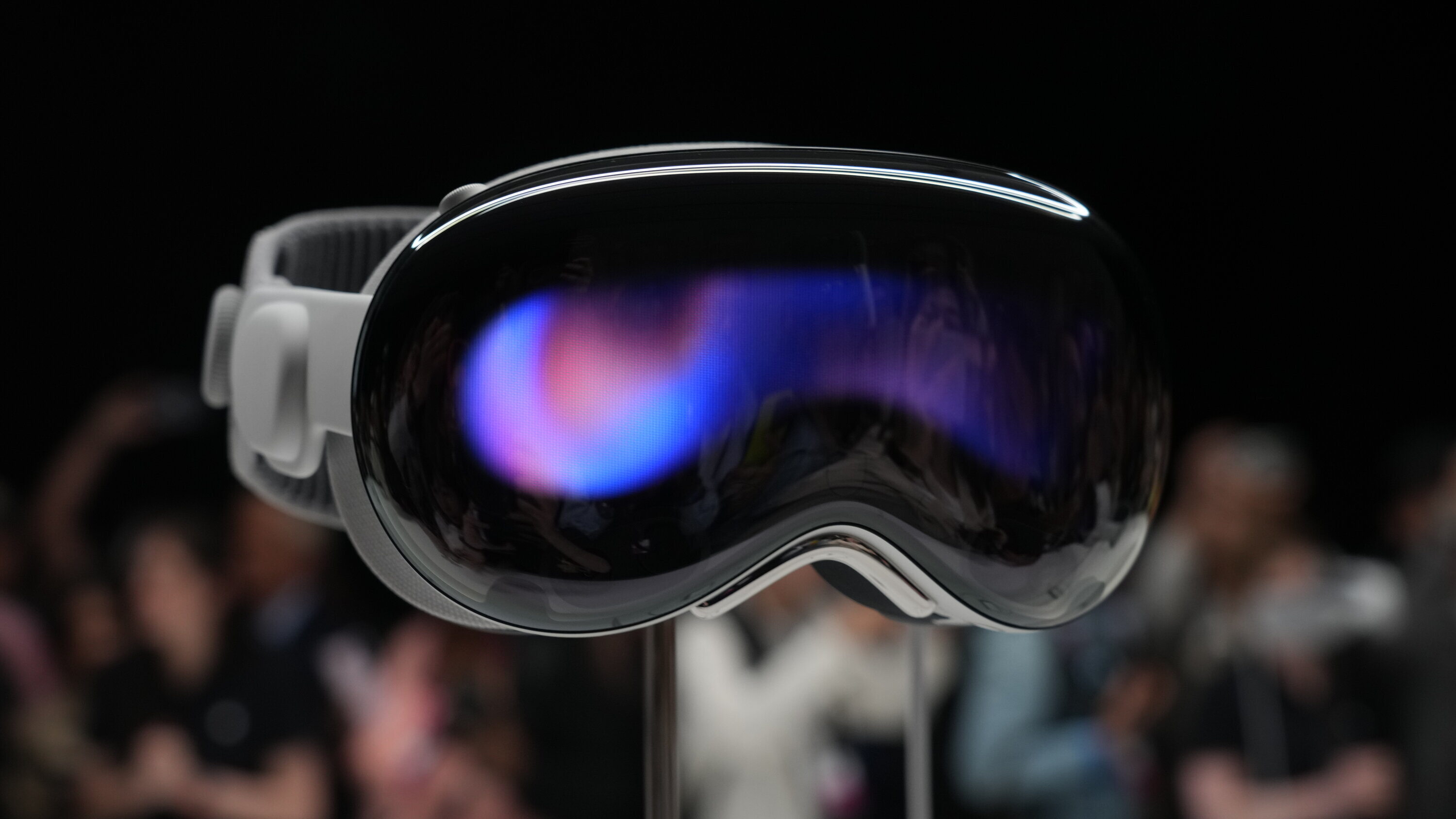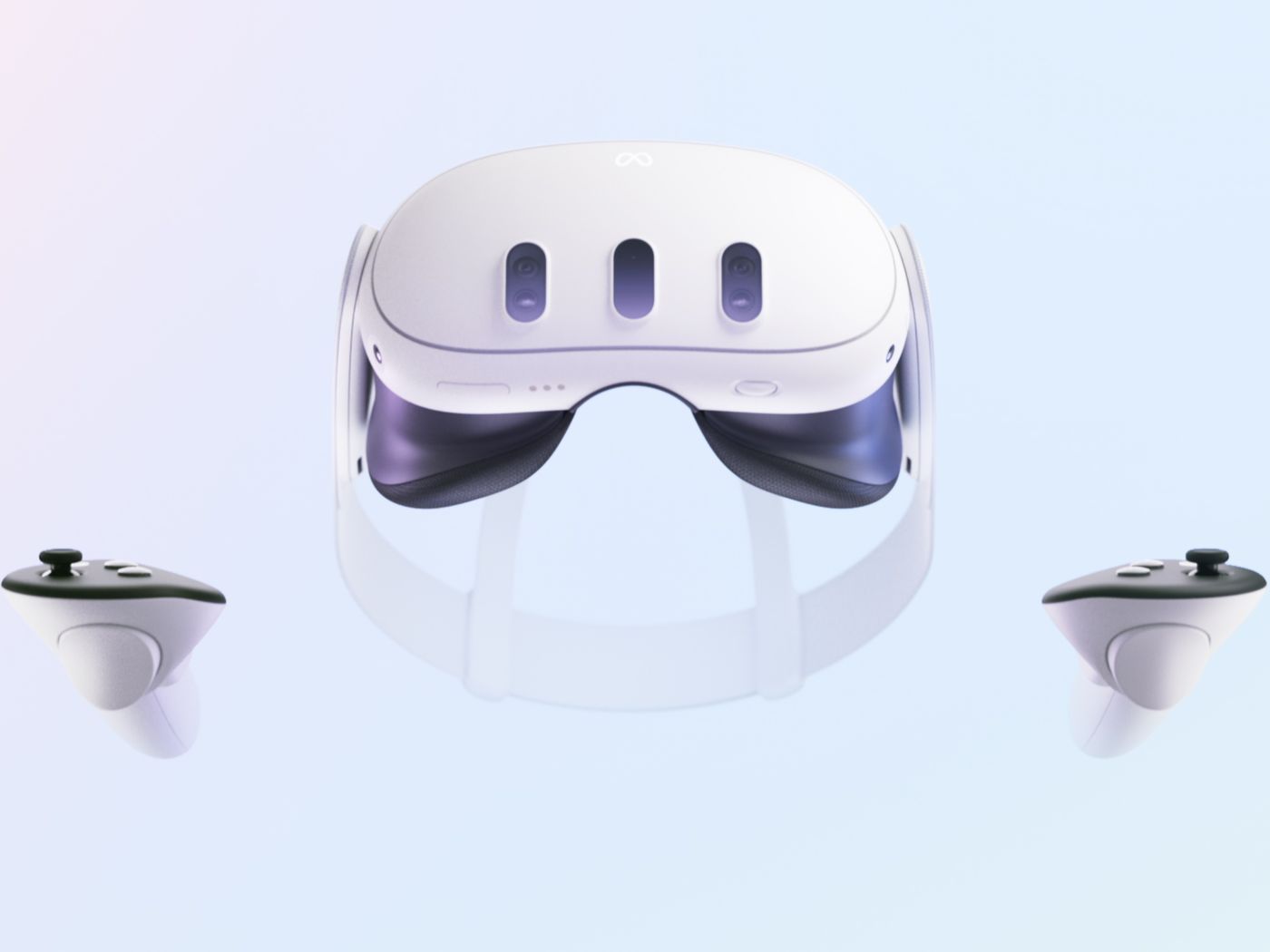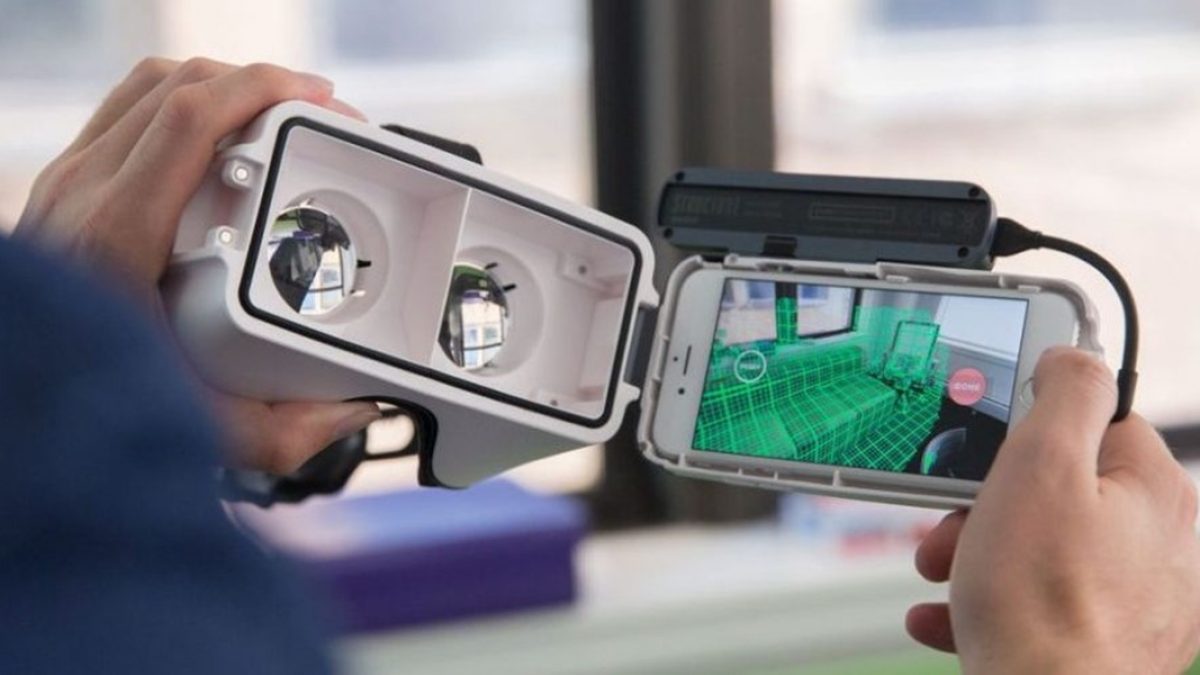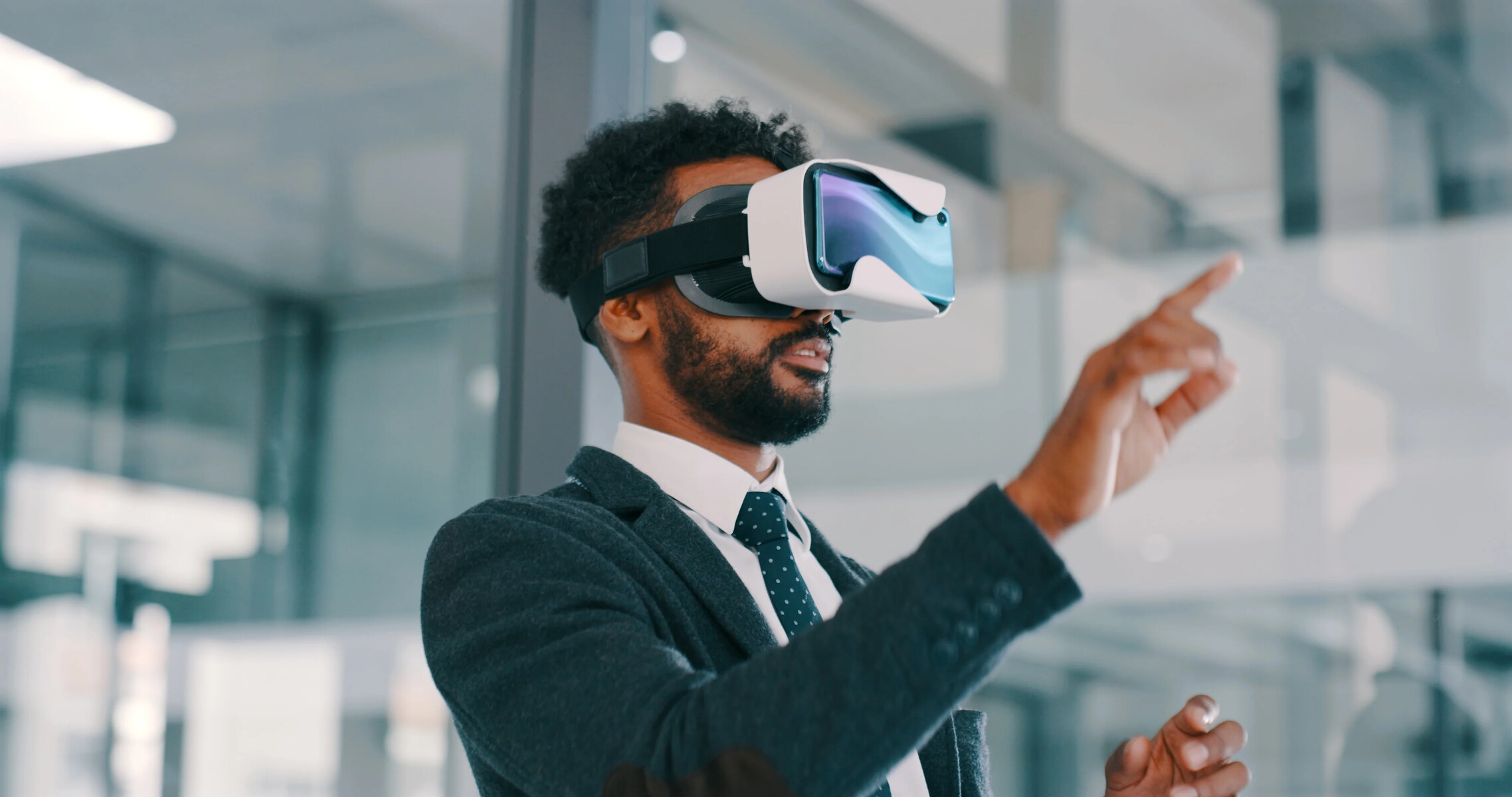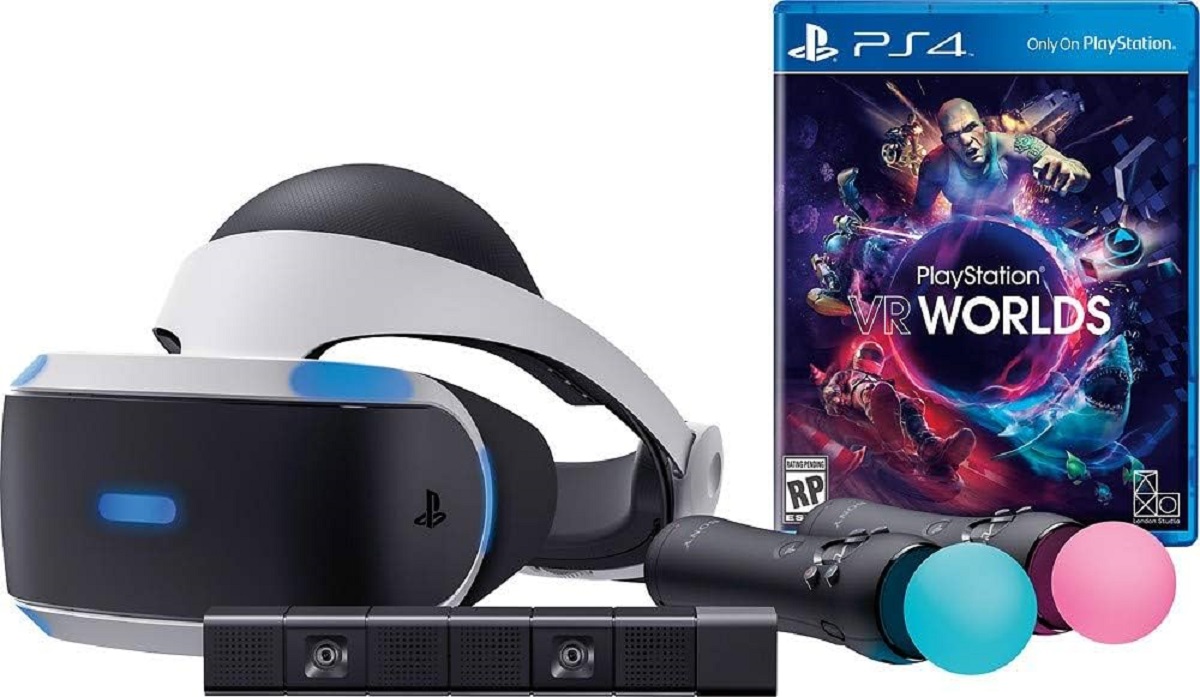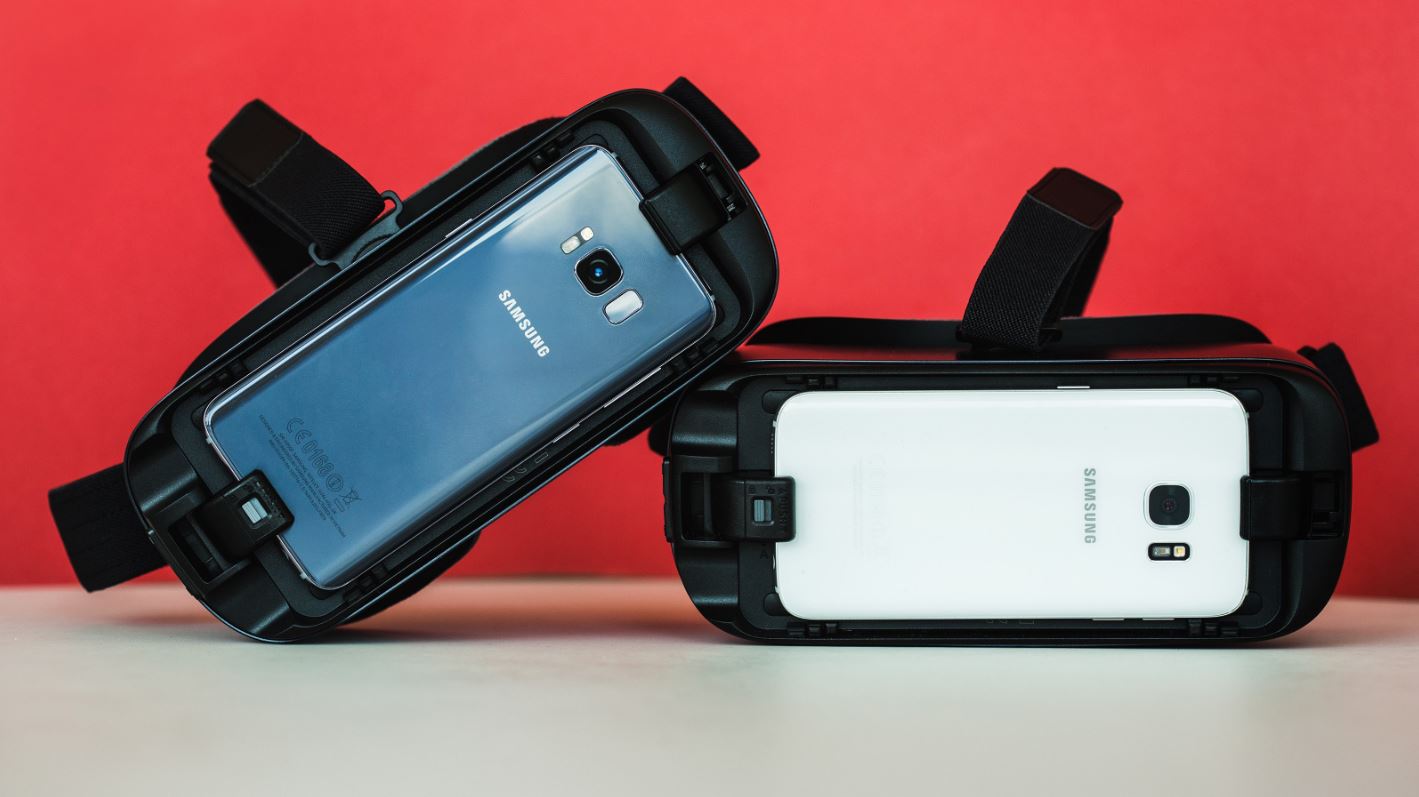Introduction
Welcome to the fascinating world of Virtual Reality (VR)! This groundbreaking technology has revolutionized various industries and transformed the way we experience digital content. From immersive gaming adventures to virtual travel experiences, VR offers a whole new level of engagement and escapism.
Virtual Reality, often abbreviated as VR, refers to a computer-generated simulation of a three-dimensional environment that can be interacted with and explored by an individual. By wearing a VR headset, users are transported into a simulated world that can mimic real or imaginary settings. Through the integration of audio and visual effects, users can experience a sense of presence and immerse themselves in a virtual world that feels incredibly lifelike.
The concept of VR has been around for decades, but recent advancements in technology have made it more accessible and realistic than ever before. As a result, VR has gained significant popularity and is being utilized across numerous industries, including gaming, entertainment, training, education, healthcare, engineering, and architecture.
In this article, we will explore the various components of virtual reality, delve into its applications in different fields, and discuss the limitations and challenges that VR technology faces.
So, buckle up and get ready to embark on a thrilling journey through the realm of virtual reality!
Definition of Virtual Reality
Virtual Reality (VR) can be defined as an advanced technology that allows users to experience and interact with a computer-generated environment in a realistic and immersive way. It is a simulated experience that can replicate both the physical and sensory aspects of the real world or create entirely imaginary landscapes.
Through the use of specialized hardware and software, Virtual Reality aims to recreate the sights, sounds, and even the tactile sensations that one might encounter in a real-world scenario. By wearing a VR headset, users are transported into a digital realm, where they can explore and navigate through the environment as if they were physically present.
At the core of Virtual Reality technology is the concept of “presence,” which refers to the feeling of being fully immersed and engaged within the simulated environment. The goal of VR is to create an experience that tricks the user’s senses into believing that they are experiencing the simulated world as if it were reality.
Unlike augmented reality, which overlays digital elements onto the real world, Virtual Reality aims to replace the real-world environment entirely, providing a fully immersive and isolated experience. VR technology can create a wide range of virtual experiences, from simple and static 3D environments to dynamic and interactive simulations that respond to user input.
Virtual Reality has gained considerable popularity in recent years, thanks to advancements in technology that have made it more accessible and affordable. While early VR experiences were limited to high-end gaming systems and research labs, today, there are a variety of consumer-grade VR devices available, catering to different budgets and preferences.
Whether used for entertainment, training, or other applications, Virtual Reality has the potential to transform how we interact with digital content and open up new possibilities in various fields. As the technology continues to evolve, we can expect even more realistic and immersive experiences in the future.
History of Virtual Reality
The concept of Virtual Reality (VR) has a rich and fascinating history, spanning several decades of technological advancements and visionary ideas. While the roots of VR can be traced back to the early 20th century, the development of the technology truly began to take shape in the 1960s.
In 1962, Morton Heilig, often considered the “Father of Virtual Reality,” introduced the Sensorama, an arcade-style machine that offered a multi-sensory virtual experience. The Sensorama incorporated 3D visuals, stereo sound, motion, and even smell to immerse users in a simulated environment. Although the Sensorama was not a commercial success, it laid the groundwork for future innovations in VR technology.
In the 1980s, the term “Virtual Reality” was coined by Jaron Lanier, an American computer scientist and pioneer of VR. During this decade, VR research gained momentum, driven by advancements in computer graphics and interactive technology. Companies like VPL Research, founded by Lanier, introduced early VR systems, such as the DataGlove and the EyePhone, which allowed users to interact with virtual environments.
However, it wasn’t until the 1990s that Virtual Reality gained widespread attention and recognition. In 1992, Sega released the Sega VR headset for gaming consoles, marking one of the first commercial attempts at bringing VR to the mainstream. Unfortunately, technical limitations and health concerns regarding motion sickness hampered its success.
Throughout the 90s, VR continued to evolve as computer processing power and graphics capabilities improved. The development of the first head-mounted displays (HMDs), such as the VFX1 and the CyberMaxx, brought VR experiences closer to reality. At the same time, industries beyond gaming began to explore the potential of VR, including military training, medical simulations, and architectural design.
In the early 2000s, VR technology experienced a decline in interest and investment, largely due to high costs and limited commercial applications. However, the visionaries in the field persisted, laying the groundwork for the comeback of VR in the following decade.
In 2010, Palmer Luckey, a young entrepreneur, sparked a renewed interest in VR with the development of the Oculus Rift, a high-quality VR headset that redefined consumer-grade virtual experiences. This breakthrough led to a resurgence in VR development, with major tech companies like HTC, Sony, and Samsung entering the market with their VR devices.
Today, Virtual Reality continues to evolve rapidly, with advancements in display technology, motion tracking, and haptic feedback. From entertainment and gaming to education, healthcare, and beyond, VR is finding applications across various industries, promising exciting possibilities for the future.
Components of Virtual Reality
Virtual Reality (VR) is made possible through the integration of several key components that work together to create an immersive and interactive virtual experience. These components include headsets, controllers, sensors, and software applications.
1. Headsets: The VR headset is the primary piece of hardware that users wear on their heads to view the virtual environment. It typically consists of a high-resolution display, lenses, and sensors to track head movements. Headsets can be tethered to a computer or connected wirelessly to a console or smartphone, providing a wide field of view and delivering stereoscopic 3D visuals.
2. Controllers: Controllers are handheld devices that allow users to interact with virtual objects and navigate through the virtual world. They can come in various forms, such as handheld motion controllers, gamepads, or even gloves with haptic feedback capabilities. Controllers provide users with a sense of presence and enable them to manipulate objects, trigger actions, and perform gestures within the virtual environment.
3. Sensors: Sensors play a crucial role in tracking the user’s movements and translating them into the virtual world. These sensors can be mounted on the headset, controllers, or external devices, depending on the VR system. They monitor the user’s position, orientation, and gestures, enabling real-time feedback and interaction in the virtual environment.
4. Software and Applications: VR software and applications are the backbone of virtual reality experiences. They encompass the digital content, simulations, and interactive elements that make up the virtual environment. From gaming and entertainment to training and education, VR applications vary widely in their purpose and functionality. Developers create immersive experiences by designing realistic environments, interactive objects, and engaging gameplay mechanics.
Combined, these components work in harmony to create a seamless and immersive virtual reality experience. The headset provides visual and auditory stimulation, while the controllers and sensors enable users to interact with and navigate through the virtual environment. The software and applications bring the virtual world to life, providing engaging and captivating experiences.
As VR technology continues to advance, we can expect further innovations and improvements in these components. Future developments may include advancements in display resolution, more intuitive and ergonomic controllers, enhanced tracking systems, and increasingly sophisticated software applications.
Headsets
Headsets are a crucial component of Virtual Reality (VR) technology, as they provide users with the visual and auditory immersion necessary to experience virtual environments. These wearable devices come in various forms and play a pivotal role in enabling users to step into the digital world.
There are generally two types of VR headsets: tethered and standalone.
Tethered Headsets: Tethered headsets are connected to a computer or gaming console through cables. They offer high-fidelity graphics and immersive experiences thanks to their reliance on the processing power of the connected device. Tethered headsets often provide a wide field of view and precise motion tracking, allowing users to fully explore and interact with the virtual environment. Examples of popular tethered headsets include the Oculus Rift, HTC Vive, and PlayStation VR.
Standalone Headsets: Standalone headsets are self-contained and do not require any external devices or cables. They have built-in displays, processors, and storage, allowing users to experience VR without the need for a computer or console. Standalone headsets offer a more convenient and portable experience, making them ideal for on-the-go use. Notable standalone headsets include the Oculus Quest, HTC Vive Focus, and Lenovo Mirage Solo.
Regardless of the type, VR headsets typically include key features that enhance the experience:
High-resolution displays: Headsets incorporate high-resolution displays, enabling users to perceive clear and detailed imagery. The resolution affects the level of visual immersion, with higher resolutions providing more realistic and lifelike visuals.
Lenses: Lenses in VR headsets are responsible for focusing the display and creating the stereoscopic effect. They allow the user’s eyes to perceive depth and provide a more realistic 3D experience.
Head Tracking: Headsets utilize sensors to track the user’s head movements and adjust the displayed content accordingly. This tracking allows users to look around and explore the virtual environment in a natural and intuitive way.
Audio Integration: Headsets often incorporate integrated headphones or built-in speakers to provide spatial audio cues. The audio enhances the sense of immersion by creating a realistic soundscape that corresponds with the virtual environment.
The VR headset landscape is continuously evolving, with advancements in display technology, ergonomics, and wireless capabilities. Manufacturers are focusing on reducing the size and weight of the headsets while improving comfort and overall user experience. As the technology progresses, we can anticipate even more realistic, comfortable, and accessible headsets that contribute to the growth and adoption of virtual reality across various industries.
Controllers
Controllers are an essential component of Virtual Reality (VR) systems, offering users a way to interact with and manipulate virtual objects within the digital environment. These handheld devices enable intuitive and immersive experiences by translating physical movements and gestures into actions in the virtual world.
There are several types of controllers used in VR applications, each offering unique features and functionality:
Motion Controllers: Motion controllers are handheld devices equipped with sensors that track their position and orientation in real-time. These controllers often have buttons, triggers, thumbsticks, and touchpads, allowing users to interact with virtual objects through physical input. The sensors capture the user’s gestures and movements, translating them into the virtual space and providing a sense of presence and realism.
Gamepads: Gamepads are familiar input devices commonly used in gaming platforms. They feature a directional pad, buttons, and analog sticks, providing users with a familiar and comfortable interface for navigating virtual environments and interacting with virtual objects. Gamepads are versatile controllers that offer precise control and are widely supported across VR systems.
Gloves and Haptic Feedback: Gloves equipped with sensors and haptic feedback technology take VR interaction to the next level. These gloves provide users with the ability to touch and feel virtual objects through the sense of touch. Haptic feedback mechanisms, such as vibrations or pressure sensors, simulate the sensation of touching, grabbing, or manipulating objects, adding a significant layer of immersion to the virtual experience.
Controllers play a crucial role in enhancing user engagement and interaction within VR environments. They enable users to perform actions such as grabbing, throwing, pointing, and drawing, making the virtual experience more natural and intuitive.
Developers are continually exploring new ways to improve controllers, focusing on enhancing ergonomics, precision, and feedback mechanisms. Future advancements may include more sophisticated motion tracking, the integration of biometric sensors for hand and finger movement, and the development of more immersive haptic feedback technologies.
With the evolution of VR controllers, users can expect increasingly realistic and immersive interactions, contributing to the growth and adoption of VR technology in various industries, such as gaming, education, healthcare, and training.
Sensors
Sensors are an integral part of Virtual Reality (VR) technology, enabling the tracking of user movements and interactions within the virtual environment. These sensors play a critical role in providing real-time feedback, enhancing the sense of presence, and creating a seamless and immersive VR experience.
There are various types of sensors used in VR systems:
Head Tracking Sensors: Head tracking sensors are vital for monitoring the position and orientation of the user’s head. They typically employ technologies such as gyroscopes, accelerometers, and magnetometers to capture the user’s movements accurately. By tracking head movements, VR systems can update the displayed visuals and adjust the perspective in real-time, allowing users to look around and explore the virtual environment naturally.
Positional Tracking Sensors: Positional tracking sensors go beyond head tracking and track the user’s entire body movements within the virtual space. Using techniques like infrared cameras and markers, laser-based sensors, or inside-out tracking, these sensors precisely determine the user’s position in relation to the environment. This enables interactive experiences that involve walking, crouching, and reaching within virtual environments, enhancing immersion and realism.
Gesture Tracking Sensors: Gesture tracking sensors capture the user’s hand and finger movements, allowing for intuitive and natural interactions within virtual environments. These sensors can utilize cameras, depth sensors, or wearable devices equipped with motion sensors to track and interpret gestures accurately. Gesture tracking enables users to manipulate virtual objects, press buttons, or perform hand gestures in a virtual space, adding a layer of realism and interactivity.
Additionally, external tracking systems, such as infrared sensors or laser arrays, can be used to create a tracked space for room-scale VR experiences. These systems monitor the position of the user and any additional objects or accessories, ensuring accurate and responsive tracking within a dedicated play area.
As VR technology continues to advance, sensor capabilities are being refined to provide more accurate and natural interaction within virtual environments. Future developments may include higher resolution, wider tracking ranges, decreased latency, and improved reliability.
The integration of various sensors in VR systems enables the translation of physical movements to virtual actions, granting users a sense of presence and immersion. By capturing and responding to movements, VR systems create a dynamic and interactive experience, pushing the boundaries of digital engagement in industries such as gaming, simulation, training, and beyond.
Software and Applications
Software and applications play a vital role in unlocking the true potential of Virtual Reality (VR). They encompass the digital content, simulations, and interactive elements that create immersive and engaging virtual experiences.
VR software and applications are developed for a wide range of purposes and industries:
Gaming and Entertainment: Gaming is one of the most prominent and popular applications of VR technology. Virtual Reality gaming takes players into fully immersive and interactive environments, allowing them to become part of the game world. VR games often utilize the capabilities of VR headsets and controllers to offer users a unique and captivating gaming experience, where they can explore virtual worlds, interact with objects and characters, and participate in engaging gameplay mechanics.
Training and Education: VR has revolutionized the fields of training and education by offering realistic and immersive simulations that enhance learning experiences. From flight simulators for pilots to medical training simulations for doctors and surgeons, VR enables trainees to practice real-world scenarios in a safe and controlled environment. VR applications in education provide students with interactive learning experiences, allowing them to explore historical sites, dive into the depths of the ocean, or visualize complex concepts in a hands-on and engaging manner.
Healthcare and Therapy: VR is being increasingly utilized in healthcare and therapy settings. It can provide therapeutic benefits by creating immersive environments that help patients manage pain, reduce anxiety, or overcome phobias. VR-based therapies are also used for physical rehabilitation, allowing patients to undergo rehabilitative exercises in a virtual setting. Moreover, VR is used for medical training, enabling medical professionals to practice surgeries, diagnostic procedures, and emergency simulations.
Engineering and Architecture: VR is transforming the fields of engineering and architecture by offering immersive experiences for design and visualization. Architects can create virtual walkthroughs of buildings, allowing clients to experience and provide feedback on designs before construction begins. Engineers can use VR to simulate and analyze industrial processes, aiding in efficient and safe design and operation procedures.
VR software developers utilize various tools and technologies to create immersive experiences. They leverage computer graphics, 3D modeling, animation, and sound design to build realistic virtual environments. They also employ advanced algorithms for physics and collision detection, enabling interactions with virtual objects and environments.
As VR technology continues to evolve, we can expect even more advanced software and applications. With advancements in artificial intelligence, haptic feedback, and social integration, VR experiences will become more realistic, dynamic, and interactive, opening up new frontiers in entertainment, training, healthcare, and various other industries.
Gaming and Entertainment
Virtual Reality (VR) has revolutionized the gaming and entertainment industry, offering immersive and interactive experiences that transport players into virtual worlds. VR gaming and entertainment have redefined traditional forms of entertainment, allowing users to actively engage with digital content like never before.
Immersive Gaming Experiences: VR gaming takes players beyond the confines of a screen, plunging them into fully immersive virtual environments. With the use of VR headsets and controllers, players can physically and mentally interact with the game world. The sense of presence and realism offered by VR technology creates a heightened level of immersion, making players feel as if they are truly part of the game. From thrilling adventures to heart-pounding action, VR gaming offers a new level of engagement and excitement.
Interactive Storytelling: VR has also opened up new possibilities for interactive storytelling. Rather than passively watching a story unfold, users can actively participate and make choices that impact the narrative. VR storytelling puts users in the center of the action, immersing them in captivating narratives and allowing them to become active participants in the story’s development. This level of immersion creates a deep sense of connection and engagement with the characters and the plot.
Social VR Experiences: VR is not limited to individual solitary experiences. It also offers social interactions and multiplayer experiences in virtual environments. Users can connect with friends and strangers from around the world, exploring virtual spaces together, participating in multiplayer games, or simply engaging in conversations in virtual chat rooms. Social VR experiences bring people together in immersive and interactive ways, enhancing the sense of presence and camaraderie.
Virtual Travel and Exploration: With VR, users can embark on virtual travel experiences without leaving their homes. From exploring distant destinations and historical sites to diving into the depths of the ocean or roaming through fantastical realms, VR travel allows users to virtually experience new places and cultures. It offers a cost-effective and accessible way to broaden horizons and satisfy the wanderlust within.
VR technology has not only transformed the way we play games but also expanded the concept of entertainment as a whole. It blurs the line between the digital realm and the real world, allowing users to escape from reality and immerse themselves in new and exciting virtual experiences.
As VR technology continues to evolve, advancements in graphics, motion tracking, haptic feedback, and artificial intelligence will further enhance the gaming and entertainment experiences. The future of VR gaming and entertainment holds tremendous potential for innovation, captivating users with even more realistic, immersive, and interactive experiences.
Training and Education
Virtual Reality (VR) has revolutionized training and education by creating immersive and interactive virtual environments that enhance learning experiences. From simulating real-world scenarios to offering hands-on training, VR technology has transformed how we acquire knowledge and develop skills.
Realistic Simulations: VR provides a safe and controlled environment for training by simulating real-world scenarios. For example, VR can replicate medical procedures, allowing doctors and nurses to practice surgeries or emergency situations without risk to patients. In industries such as aviation or the military, VR simulations offer trainees opportunities to practice complex operations, flight maneuvers, or combat scenarios in a realistic and immersive way.
Hands-on Learning: VR allows for hands-on learning experiences that are otherwise challenging or expensive to recreate in traditional educational settings. Students can manipulate objects, conduct experiments, and interact with virtual models, enabling a deeper understanding of complex concepts in subjects like science, engineering, and architecture.
Engaging and Interactive Content: VR brings educational content to life by offering engaging and interactive experiences. Students can explore historical landmarks, visualize abstract concepts, or take a virtual journey through space. The immersive nature of VR captivates learners’ attention and promotes active engagement, making learning more enjoyable and effective.
Personalized Learning: VR technology enables personalized learning experiences tailored to the needs and abilities of individual learners. With adaptive content and assessments, VR educational applications can adjust the difficulty level or pace of instruction based on learner progress. This personalized approach promotes effective learning and ensures each student receives the necessary support and challenges.
Global Access to Education: VR has the potential to provide equal access to quality education regardless of physical location or socioeconomic status. Through VR-enabled distance learning, students can participate in virtual classes, engage with instructors, and collaborate with peers from anywhere in the world. VR also opens doors for remote or underserved communities to access educational resources and experiences that were previously out of reach.
The integration of VR into training and education is continually expanding, with applications in various fields such as healthcare, STEM education, skills training, and professional development. As the technology advances, VR holds the promise of transforming the way we learn and acquire new knowledge.
With ongoing innovations in VR hardware, software, and content development, the future of training and education looks increasingly immersive, engaging, and accessible. VR will continue to play a pivotal role in revolutionizing education and preparing learners for the challenges of the modern world.
Healthcare and Therapy
Virtual Reality (VR) technology has become a valuable tool in the healthcare industry, offering innovative solutions for treatment, therapy, and training. By leveraging the immersive and interactive capabilities of VR, healthcare professionals can enhance patient care, rehabilitation, and medical training in ways that were previously unimaginable.
Pain Management and Distraction: VR has proven effective in pain management, providing a distraction for patients during medical procedures, wound dressings, or physical therapy sessions. By immersing patients in virtual environments, VR can divert their attention away from pain and discomfort. The immersive experiences offered by VR have been shown to reduce pain perception and anxiety, improving the overall patient experience.
Phobia and Anxiety Treatment: VR is increasingly used in the treatment of phobias and anxiety disorders. By exposing individuals to virtual simulations of their fears in a controlled environment, therapists can gradually desensitize patients to their phobias or anxieties. VR therapy enables individuals to confront their fears in a safe and controlled manner, leading to reduced anxiety and improved outcomes in therapy.
Physical Rehabilitation: VR-based rehabilitation programs have demonstrated benefits in assisting patients with physical injuries or disabilities. VR simulations can recreate real-world environments and activities, enabling patients to practice movements, balance, and coordination in a virtual setting. This immersive therapy helps promote motor function recovery and enhances patient engagement and motivation during rehabilitation exercises.
Medical Training and Education: VR has transformed medical training by offering realistic simulations of medical procedures, surgeries, and emergency scenarios. Medical professionals can practice their skills and decision-making in a safe environment before performing them on real patients. VR-based training enhances competency, reduces the risk of errors, and improves patient safety. It enables trainees to experience rare or critical cases that may be challenging to encounter during traditional training methods.
Mental Health Therapy: VR is utilized in mental health therapy, particularly in the treatment of anxiety disorders, PTSD, and stress-related conditions. Therapists can create virtual environments that simulate trigger situations, allowing patients to confront and manage their anxieties in a controlled setting. VR therapy can also provide opportunities for role-play, observational learning, and mindfulness exercises, enhancing the effectiveness of traditional therapeutic techniques.
The integration of VR in healthcare and therapy continues to evolve rapidly, with ongoing advancements in hardware, software, and content development. As technology advances, VR has the potential to revolutionize patient care, rehabilitation methods, and medical education, leading to improved outcomes and enhanced quality of life for individuals around the world.
Engineering and Architecture
Virtual Reality (VR) technology has had a transformative impact on the fields of engineering and architecture, offering powerful tools for design, visualization, and simulation. VR enables professionals in these industries to create, explore, and optimize models in a virtual environment, revolutionizing the way projects are conceived, reviewed, and executed.
Design Visualization: VR allows architects and engineers to visualize their designs in a fully immersive and interactive manner. Through VR simulations, professionals can walk through virtual buildings, assess spatial relationships, and make design decisions in a realistic context. This immersive experience offers valuable insights into the scale, proportions, and aesthetics of the project, leading to more informed design choices.
Virtual Prototyping: VR facilitates virtual prototyping, allowing engineers and architects to efficiently test and refine designs before costly physical prototypes are built. With VR, professionals can assess structural integrity, mechanical functionality, and other design aspects in a virtual environment. This reduces the need for physical iterations, saving time and resources while validating design concepts.
Collaborative Design Review: VR brings new possibilities for collaborative design review and client presentations. Multiple stakeholders can explore the virtual models simultaneously, providing feedback and making real-time design decisions, even if they are located in different parts of the world. VR enhances communication and facilitates a shared understanding of the project vision, leading to more effective collaboration and faster project approvals.
Site Planning and Visualization: VR is instrumental in site planning by allowing professionals to visualize how buildings or structures will fit into existing landscapes or urban environments. VR simulations can provide insights into sun exposure, shadows, traffic flow, and other site-specific factors. This information aids in optimizing building orientation, assessing environmental impact, and making informed decisions during the early stages of planning and design.
Training and Safety Simulations: VR-based training simulations allow engineers and construction workers to practice complex operations, improve safety awareness, and enhance skills in a risk-free environment. Virtual simulations can replicate construction sites, equipment operation, and hazardous scenarios, providing invaluable hands-on experience and enabling workers to anticipate and mitigate potential risks.
The integration of VR in engineering and architecture continues to expand as technology advances. As graphics capabilities, hardware performance, and VR design tools improve, the level of realism, interactivity, and immersion in VR experiences will advance. This evolution will drive innovation, efficiency, and sustainability in engineering and architectural practices.
Ultimately, VR technology empowers professionals in these industries to push the boundaries of creativity, envision possibilities, and streamline the design and construction processes, resulting in more efficient, sustainable, and visually captivating structures and infrastructure.
Limitations and Challenges of Virtual Reality
While Virtual Reality (VR) technology has seen rapid advancements and widespread adoption, it still faces certain limitations and challenges that need to be addressed for its continued growth and improvement. These limitations impact factors such as user experience, accessibility, and cost.
Motion Sickness: Motion sickness is a common challenge for some users when using VR headsets. The sensory disconnect between the user’s visual perception and physical movement can cause discomfort, dizziness, or nausea. This issue is being addressed through advancements in hardware, software optimization, and user comfort design.
Accessibility: One significant challenge for VR is accessibility. VR systems often require high-end computers or gaming consoles, which can be expensive and may not be accessible to everyone. Additionally, the physical setup requirements, such as dedicated play areas or specific room configurations for full VR experiences, limit accessibility for those with limited space.
Cost: The cost associated with VR equipment and software can be a barrier for widespread adoption. While VR technology has become more affordable in recent years, high-quality VR headsets and powerful computing systems still come at a considerable price, making it less accessible to certain individuals or organizations.
Hardware Limitations: VR hardware continues to improve, but there are still limitations to be addressed. Issues such as the resolution of displays, field of view, and the weight and comfort of headsets impact the overall user experience. Improvements in resolution, field of view, and ergonomics are actively being pursued by manufacturers to enhance the comfort and immersion of the hardware.
Content Development and Variety: While there is a growing library of VR content, there is still a need for more diverse and high-quality experiences. The continued growth of VR relies on the availability of compelling and engaging content across multiple genres and industries. Content developers need to bridge the gap by creating more innovative and immersive experiences that cater to a broader audience.
Privacy and Ethical Concerns: VR technology raises privacy and ethical concerns related to data collection, user tracking, and the potential for addiction or psychological effects. As VR becomes more integrated into everyday life, it will be essential to establish regulations and ethical guidelines to protect user privacy and ensure responsible use of the technology.
Despite these challenges, the ongoing advancements in VR technology continue to address many of these limitations. With continued investment, research, and innovation, VR has the potential to overcome these challenges, offering greater accessibility, improved user experiences, and a wider range of applications, further enriching the virtual reality landscape.
Motion Sickness
Motion sickness is a challenge that some users experience when using Virtual Reality (VR) headsets. This phenomenon occurs when there is a sensory mismatch between the user’s visual perception and their physical movement, resulting in symptoms such as uneasiness, dizziness, nausea, and in some cases, vomiting.
Motion sickness in VR is primarily caused by the discrepancy between what the user sees and what the body experiences. When users are visually immersed in a virtual environment while their physical body remains stationary, this sensory disconnect can lead to a feeling of discomfort and disorientation.
The severity of motion sickness can vary from person to person, with some individuals being more susceptible than others. Factors such as the individual’s susceptibility to motion sickness in real life and the design of the VR experience can influence the occurrence and intensity of symptoms.
To mitigate motion sickness, developers and manufacturers have implemented various techniques and strategies:
Improving Frame Rate and Latency: Maintaining a high frame rate and low latency is crucial in VR. By ensuring a smooth and responsive experience, developers can help minimize the risk of motion sickness. Higher frame rates and lower latency reduce the perceived lag between head movements and visual updates, which can contribute to a more comfortable experience.
Optimizing Visuals and Movements: Design choices related to visual elements and movement within VR experiences can impact motion sickness. Developers can employ techniques such as reducing motion blur, avoiding rapid camera movements, and implementing smooth transitions to mitigate disorientation and lessen the likelihood of motion sickness.
Implementing Field of View Comfort Adjustments: Some VR systems provide options to adjust the field of view (FOV) settings. Allowing users to customize FOV settings according to their comfort level may help alleviate motion sickness symptoms.
Gradual Exposure and Comfort Breaks: For individuals prone to motion sickness, gradually acclimating them to VR experiences can help reduce symptoms. Starting with short VR sessions and gradually increasing the duration over time can allow users to build tolerance. Additionally, taking regular breaks during VR sessions can help prevent or alleviate motion sickness.
Motion sickness in VR remains an ongoing area of research and development. Manufacturers and researchers are continually exploring innovative approaches to minimize the occurrence and impact of motion sickness through hardware advancements, improved algorithms, and optimized VR experiences.
It is worth noting that not all users experience motion sickness in VR, and for many, the discomfort diminishes or disappears with repeated use and acclimatization. As VR technology progresses and design principles evolve, motion sickness is expected to become less prevalent, making VR an even more comfortable and accessible experience for users.
Accessibility
Accessibility is a significant consideration when it comes to Virtual Reality (VR) technology. While VR offers exciting and immersive experiences, there are certain challenges that need to be addressed to ensure that VR is accessible to everyone.
Cost: One of the primary barriers to accessibility is cost. VR systems, including headsets and compatible hardware, can be expensive. To make VR more accessible, there is a need for more affordable options, including budget-friendly headsets and accessories, as well as options that work with lower-end hardware.
Physical Requirements: Many VR experiences require a dedicated physical space, referred to as room-scale VR. This can be challenging for individuals who have limited space in their homes or who may have mobility impairments. Ensuring that VR experiences can be adapted to different physical spaces and allowing for seated or smaller-scale experiences can enhance accessibility.
Sensory Considerations: VR experiences are primarily visual and auditory, which may pose challenges for individuals with sensory impairments. Consideration should be given to providing alternative forms of feedback, such as vibration or haptic feedback, and providing options for closed captions or text-based instructions for those who may have difficulty with audio cues.
Usability and Interface Design: VR experiences should be user-friendly, with intuitive and accessible interfaces. Clear instructions and well-designed user interfaces can help individuals navigate VR environments more easily. Considerations should also be given to designing interfaces that are accessible to users with varying levels of digital literacy or cognitive impairments.
Content Accessibility: Ensuring that there is a variety of accessible and inclusive content available for VR experiences is essential. Developers should strive to create experiences that cater to diverse audiences and consider accessibility features, such as customizable user interface elements or options for different languages and subtitles.
Health Considerations: VR experiences should take into account potential health issues or considerations to ensure accessibility for all users. This includes enabling features or options to reduce motion sickness, providing comfort adjustments for users with physical limitations, and avoiding content that may trigger seizures or other adverse health effects.
Addressing these accessibility challenges will foster inclusivity and expand the reach of VR technology to a broader audience. It requires collaboration among hardware manufacturers, software developers, and content creators to create more affordable, adaptable, and user-friendly VR solutions.
As the VR industry continues to evolve, efforts to improve accessibility will enhance the potential of VR technology to provide immersive experiences for individuals of all backgrounds, abilities, and circumstances.
Cost
Cost is a significant consideration when it comes to Virtual Reality (VR) technology. While VR offers incredible immersive experiences, the cost associated with VR equipment and software can be a barrier for widespread adoption.
Headsets and Hardware: VR headsets and compatible hardware, such as powerful computers or gaming consoles, can be expensive. High-end VR headsets from reputable manufacturers often carry a significant price tag, making them inaccessible to individuals with limited budgets. Additionally, the hardware required to run VR experiences at optimal performance can be costly, which further adds to the overall cost of ownership.
Additional Accessories: Depending on the VR system, additional accessories may be needed for an optimal experience. These accessories include items like motion controllers, additional sensors, or external tracking systems. While they may enhance interactivity and immersion, they also contribute to the overall cost of the VR setup.
Software and Content: In addition to the upfront cost of hardware, acquiring VR software and content can also be a consideration. While some VR applications and experiences are available for free, others may require additional purchases or subscriptions. Building a library of diversified VR content can add to the overall cost of ownership.
Upgrades and Maintenance: VR technology is continuously evolving, with improvements in graphics, performance, and features. Staying up to date with the latest hardware releases or software updates may require additional investments in upgrades. Additionally, regular maintenance and upkeep, such as replacing worn-out components, can contribute to the cost of owning and maintaining a VR setup.
Affordability and Accessibility: The high cost of VR equipment can limit its accessibility, particularly for individuals or organizations with limited financial resources. Improving affordability through the development of more budget-friendly VR options and promoting competition among manufacturers can foster wider adoption and make VR technology more accessible to a broader audience.
Despite the initial cost outlay, it’s worth noting that VR technology has become more affordable in recent years. Entry-level VR headsets have hit the market at lower price points, and prices for higher-end devices have become more competitive. As technology continues to advance and economies of scale come into play, the cost of VR is expected to decrease over time.
Cost reduction efforts coupled with increased awareness and demand will drive innovation, encouraging manufacturers to develop more affordable and accessible VR solutions. A more accessible and affordable VR landscape has the potential to unlock new possibilities across various industries and make interactive virtual experiences available to a wider range of users.
Conclusion
Virtual Reality (VR) technology has emerged as a transformative force, revolutionizing various industries and offering immersive and interactive experiences like never before. From gaming and entertainment to training, education, healthcare, and beyond, VR has the potential to reshape how we experience digital content, learn, and engage with our surroundings.
The components of VR, including headsets, controllers, sensors, and software applications, work together to create realistic and engaging virtual experiences. Advancements in hardware, software, and content development have made VR more accessible and affordable, expanding its reach to a broader audience.
While VR technology has come a long way, there are still challenges and limitations that need to be addressed. Motion sickness, accessibility, cost, and content diversity are among the key considerations for further development and improvement. Efforts to minimize motion sickness, enhance accessibility, reduce costs, and provide a wider range of high-quality content will contribute to the continued growth and adoption of VR technology.
As VR technology evolves, we can anticipate even more immersive experiences, higher display resolutions, enhanced motion tracking, and improvements in usability and comfort. With advancements in artificial intelligence, haptic feedback, and social integration, VR is poised to deliver increasingly realistic, interactive, and engaging experiences across various industries and applications.
VR has the potential to transform the way we learn, entertain, communicate, and experience the world around us. The future of VR looks promising, with endless opportunities to create new and extraordinary experiences that push the boundaries of human imagination and interaction.







